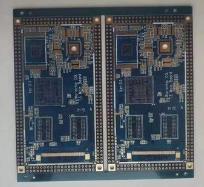The complete PCB we envision is usually a regular rectangular shape. Although most designs are indeed rectangular, many PCB designs require irregular-shaped circuit boards, and such shapes are often not easy to design. This article describes how to design irregular-shaped PCBs.
Nowadays, the size of the PCB is shrinking, and the functions in the circuit board are also increasing. Coupled with the increase of the clock speed, the design has become more and more complicated. So, let's take a look at how to deal with circuit boards with more complex shapes.
As shown in Figure 1, a simple PCI board shape can be easily created in most EDA Layout tools.
However, when the circuit board shape needs to be adapted to a complex housing with height restrictions, it is not so easy for PCB designers, because the functions in these tools are not the same as those of mechanical CAD systems.

The complex circuit board shown in Figure 2 is mainly used for explosion-proof enclosures and therefore is subject to many mechanical limitations. Rebuilding this information in EDA tools may take a long time and is not very effective. Because, mechanical engineers are likely to have created the housing, circuit board shape, mounting hole location, and height restrictions required by the PCB designer.
Due to the arc and radius in the circuit board, the reconstruction time may be longer than expected even if the circuit board shape is not complicated. These are just a few examples of complex circuit board shapes. However, from today's consumer electronics products, you will be surprised to find that many projects try to add all the functions in a small package, and this package is not always rectangular. You should think of smartphones and tablets first, but there are many similar examples.
If you return the rented car, you may be able to see the waiter read the car information with a handheld scanner, and then wirelessly communicate with the office. The device is also connected to a thermal printer for instant receipt printing. In fact, all of these devices use rigid/flexible circuit boards (Figure 4), where traditional PCB circuit boards are interconnected with flexible PCBs so that they can be folded into a small space.
Then, the question is "how to import the defined mechanical engineering specifications into PCB design tools?" Reusing these data in mechanical drawings can eliminate duplication of work, and more importantly, eliminate human errors.
We can use DXF, IDF or ProSTEP format to import all the information into PCB Layout software to solve this problem. This can save a lot of time and eliminate possible human error. Next, we will learn about these formats one by one.
DXF is the oldest and most widely used format, which mainly exchanges data between mechanical and PCB design domains electronically. AutoCAD developed it in the early 1980s. This format is mainly used for two-dimensional data exchange. Most PCB tool suppliers support this format, and it does simplify data exchange. DXF import/export requires additional functions to control the layers, different entities and units that will be used in the exchange process. Figure 5 is an example of using Mentor Graphics' PADS tool to import a very complex circuit board shape in DXF format:
A few years ago, three-dimensional functions began to appear in PCB tools, so a format that can transfer three-dimensional data between machinery and PCB tools is needed. As a result, Mentor Graphics developed the IDF format, which was then widely used to transfer circuit board and component information between PCBs and machine tools.
Although the DXF format includes the size and thickness of the circuit board, the IDF format uses the X and Y position of the component, the component location number, and the Z-axis height of the component. This format greatly improves the ability to visualize the PCB in a three-dimensional view. The IDF file may also include other information about the restricted area, such as height restrictions on the top and bottom of the circuit board.
The system needs to be able to control the content contained in the IDF file in a similar way to the DXF parameter setting. If certain components do not have height information, IDF export can add missing information during the creation process.
Another advantage of the IDF interface is that any party can move the PCB components to a new location or change the shape of the circuit board, and then create a different IDF file. The disadvantage of this method is that the entire file representing the board and component changes needs to be re-imported, and in some cases, it may take a long time due to the file size. In addition, it is difficult to determine which changes have been made with the new IDF file, especially on larger circuit boards. IDF users can eventually create custom scripts to determine these changes.